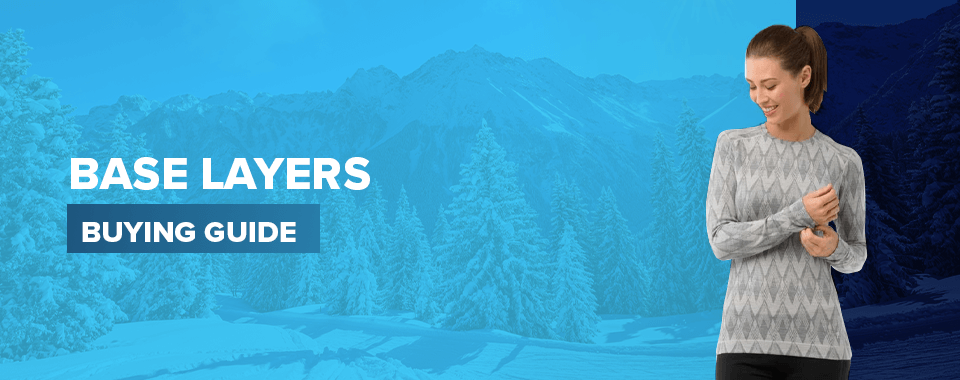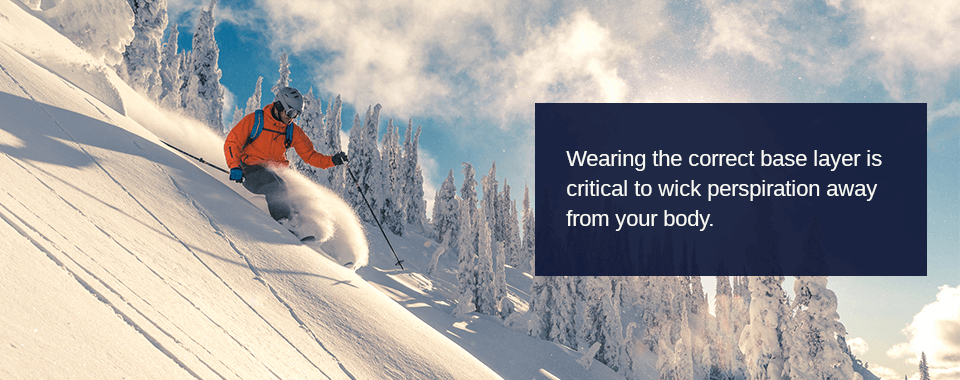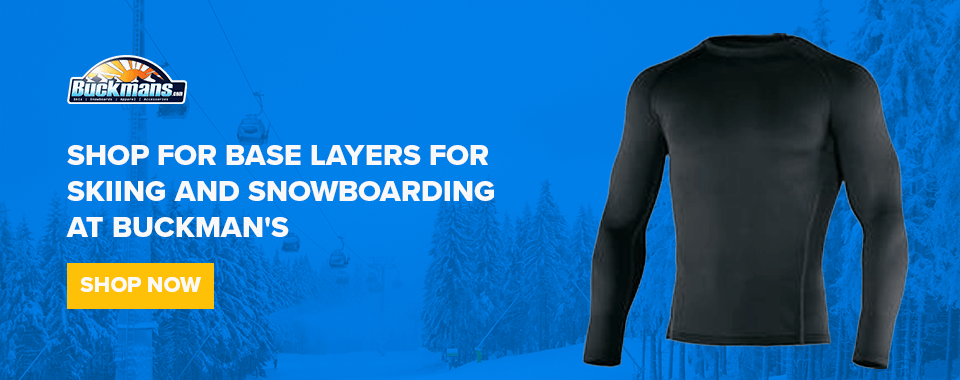 Base Layers Buying Guide
Base Layers Buying Guide
Base Layers Buying Guide
Posted
by
Matt Gahman
on Thursday, May 5, 2022
Remember that time you hiked up the mountain during the peak of winter, and you were almost as frozen as the ground? Or how about the time you were skiing with your family and everyone needed more than a few hand warmers to defrost?
At Buckman’s, we know nothing is worse than feeling numb while you’re trying to enjoy the outdoors in the snow and cold weather. When you need to stay cozy warm in the mountains, remain sweat-free playing a sport, or keep dry while skiing through deep powder, you need to invest in the best base layer for cold weather.
For you, your friends, family and children, Buckmans' experts are here to help you find what layers work for you and your level of movement. Wearing a base layer is your best defense at keeping warm, dry and active no matter what you’re getting into.
What Are Base Layers?
Choosing the best base layer is what can make or break an awesome snowboard session or family skiing trip. Base layer is a garment worn against your skin to deliver insulating properties by regulating your body temperature and moving perspiration away from your skin to keep you dry. Being dry means you’re warm, which is a necessity during the winter months.
For the most effective moisture control, you'll want to make sure your base layer allows a full range of motion while also contouring as closely to your body as possible. No matter what, the best way to stay warm in frigid conditions is to wear three layers. One base layer (top and bottom), one insulating mid layer (depending on the conditions), and a weather-proof outer layer that all work together to provide the critical elements of wicking away sweat, retaining your body heat, and keeping out the wind and rain.
Different Types of Base Layering for Skiing and Other Sports
Whether you’re in need of one or several layers, Buckman’s has what you need to stay on top of your game without freezing.
- Long-sleeve shirts are great for colder weather, especially when you pair it with additional layers. They maximize your warmth too.
- Bottoms come in full-leg or three-quarter leg versions. Full-length pants should reach your ankles while ¾ cropped bottoms are perfect for when you wear snowboard or ski boots, helping get rid of clumping that occurs with longer base layer pant legs and socks.
- One-pieces give you complete base layer protection to help seal out any air drafts. By covering almost every part of your body, one-piece options are incredible for cold weather with some even coming with hoods.
While you can wear these base layers on their own, layering helps maintain warmth, comfort and moisture control. You can use your regular shirt size to determine the correct fit for base layer shirts and pants.
Aspects to Consider When Choosing Base Layers
If you’re wondering how to choose a base layer, think about various components such as weight, material and fit. Each depends on different elements including the weather, temperature and amount of physical activity you’re performing. Base layers come in different weights as well as various thicknesses to accommodate you.
1. The Weight of a Warm Base Layer
The heaviness of the layer you choose parallels the amount of warmth provided. For example, there are light, medium and heavyweight categories where the heat retention properties depend on the fabric used and its weight. While brands differ when it comes to what’s considered light, mid and heavy weight, these are some general guidelines:
Lightweight
Base layers made of lightweight material have a thin sheet of fabric which allows you to add more clothes on top. It’s the first piece you put on to stay warm. The apparel fits close to your skin but is also comfortable, giving you the freedom to move. The design permits the addition of clothes to go over for superior moisture management. Or, you can wear the base layer alone if you’re involved in high levels of activity.
Ideal for mild or chilly weather, lightweight versions are the go-to if you’re performing anything from running and skiing to touring and climbing. Thin layers are better at wicking, faster at drying and worn by outdoor athletes. You can add layers as you wish for more endurance-based activities like cross-country skiing.
Medium Weight
Also known as a mid-weight base layer, this type is warmer than a lightweight layer. You can wear mid-weight layers right next to your skin or as a second layer over lighter base apparel. Mid-weight base layers are excellent if you combine them with lightweight materials underneath or heavier layers overtop to meet your exact warmth requirements. However, you can also wear it as a first layer. Worn alone, it’s best for cool to cold conditions while performing a medium level of activity whether you’re moving or standing for extended periods.
Heavyweight
The heaviest base layer is ideal for cold conditions and perfect for any level of activity. Also referred to as a thermal weight, it can layer over lighter weight versions. Compared to light or medium weight garments, heavyweight is thicker for extra insulation.
Because the base layer fits loosely, people don’t often wear it as a primary layer. It doesn’t matter how intense you are working — a thermal weight garment serves as a layer over top tighter accessories to provide added warmth. It delivers more insulation as opposed to wicking.
2. Types of Material Used to Create Base Layers
Different kinds of materials work in various ways to regulate your temperature, wick away moisture and protect you from the elements. The most common is Merino wool. Other materials include synthetic polyester and silk.
Merino Wool
As a natural fiber from Merino sheep, the wool has a soft hand, fine fibers and incredible thermal retention. It’s a lightweight material that resists odors and is pliable, bending up to 20,000 times before splitting for superior durability. The material is also able to reshape well after running through the washer.
Merino wool doesn't itch and bends more easily compared to traditional wool or synthetic fibers. Delivering more warmth than most other threads, it also has natural antibacterial properties with superior moisture management and temperature regulation. It is wrinkle and stain-resistant too.
Merino wool relies on moisture-absorbing rather than wicking. For example, a wool base layer can hold up to 35% of its weight in water without becoming wet to the touch. Disadvantages of Merino wool include drying slower than synthetics, possible garment shrinking, and being more expensive.
Synthetic
Made of polyester, nylon or polyester blends, synthetic material is an ideal base layer because of its superior wicking abilities. Its fibers are transparent and better at wicking moisture away from your skin as opposed to absorbing it like wool. Synthetics disperse sweat or water onto the outer surface where it can evaporate. Synthetics also dry faster than cotton which reduces the risk of swings in body temperature.
Synthetics are lightweight with a soft hand and excellent stretch. The material is also abrasion- and wrinkle-resistant and more affordable because it’s a man-made product. A disadvantage includes little odor protection. It’s also vulnerable to stains and has slower temp regulation compared to wool because it’s thinner.
Silk
Silk is the least common fabric used in the making of base layers. Made of natural fibers, it has a soft hand with great wicking capabilities because it’s thin and lightweight. Silk is ideal for cold weather conditions. On the downside, you must hand wash silk and shrinking is possible. It’s also vulnerable to abrasions and UV rays, making it not as durable.
3. The Fit of the Garment
Some people may believe a base layer should be overly tight. However, that’s not the case if you want proper circulation, insulation and wicking. You will want to find a piece of apparel that contours to your body but still allows unrestricted movement. In other words, it should be a tight but also a loose enough fit that allows you to maneuver and perform different activities — a happy medium between a shaped and moveable fit.
Selecting a layer that’s not fitted to your body type will result in an ineffective and uncomfortable layer. When the fabric is close to your skin, like with a lightweight option, it conserves your body heat and evaporates your sweat. It also enables you to fit more layers over the top. A looser fitting layer, such as a heavyweight version, allows air to flow between your skin and the fabric to trap any body heat. The fit of your base layer shouldn’t be so tight that it’s painful or restrictive.
How you determine the best fit for you and your kids is by knowing your body mass index (BMI).
Benefits of Wearing Base Layers
Like any other type of physical activity, your body builds up a sweat when skiing or snowboarding. Because this sweat gets trapped underneath your ski or snow pants, it's important to wear a base layer to absorb and evaporate it. This helps keep you warm and comfortable. However, regular pants aren't suitable to wear underneath ski pants, so you'll need to invest in a quality base layer built for extreme outdoor conditions.

Being able to add or take away layers is the ultimate way to regulate your body temp and moisture level while you’re participating in winter activities with your friends and family. Base layers are efficient and versatile by offering better warmth than a garment of thick cotton. Other advantages include:
- -Superior compression capabilities
- -Improved rate of oxygenated blood flow
- -Wicking abilities
- -Incredible insulation properties
- -Adapting to the needs of your muscles
Base layers are often a type of compression gear. The layers have seams and panels that put pressure on your extremities such as ankles and wrists. The seams lessen on your body as the material forms closer to your heart, delivering controlled pressure in the right areas.
The proper amount of compression also improves the rate of oxygenated blood that’s distributed to your muscles while deoxygenated blood transfers to your heart. With increased blood rates, you can see benefits such as:
- -Increased recovery
- -Reduced muscle fatigue
- -Boosted circulation
- -Less cramping
- -Fewer risks of injury
With mornings on the mountain reaching freezing temps and getting a bit warmer as the day moves along, being able to add or take away layers is the best way to keep up with different weather conditions and levels of activity. Wearing a few layers will help keep you warm by trapping your body heat and retaining it close to your body. Several layers are more effective than one, but all comes down to personal preference, weather and activity. Some instances may call for you to remove a layer or two for comfort.
Wicking is a unique characteristic of particular fabrics where the material draws sweat and other liquids from your body and pushes them to the outer layers of the garment. The surface area of a base layer fabric is higher than materials like cotton, making it easier for perspiration to evaporate.
Have you ever gone for a run in a cotton tee-shirt, sweated through and became cold once you started to cool or stopped moving? Wicking helps prevent that to keep your temp controlled.
Snowboarding, skiing and moving around in the cold for extended periods makes you vulnerable to weak muscles, and therefore, more injuries. Putting on base layers, though, keeps your muscles warm or in some cases, cool — contingent on how much you’re moving.
Base Layers to Wear Under Ski or Snowboard Pants
A good base layer should be snug and form-fitting to control moisture buildup — think long johns, long underwear and thermals. We recommend lightweight base layers, as they allow for more stretch and breathability in cold weather. As mentioned earlier, these come in a variety of materials such as merino wool, nylon, polyester and silk.
To help you determine the best base layers to wear under ski pants, let's compare these popular lightweight base layer materials:
- Synthetic: Synthetic materials such as polyester, polyester blends and nylon offer excellent wicking and quick-drying abilities. The main downside is their lack of odor resistance.
- Merino wool: A merino wool base layer is soft, breathable, odor-resistant, durable and effective for wicking moisture, making it another ideal choice to wear underneath ski pants or snow pants. However, it doesn't dry as quickly and can be expensive.
- Silk: Silk is a good lightweight option for cold weather, but it's also notorious for poor wicking, drying and odor-resisting abilities. It's also less durable compared to synthetic and merino wool fabrics.
When deciding what to wear under ski pants, determine which factors are most important to you — moisture-wicking abilities, drying speed, cost and odor resistance. This can help you decide what to wear under non-insulated ski pants.
Top Layering Tips
In addition to selecting the right base layer, it's equally important to consider effective top layering. When skiing or snowboarding, you should typically have three top layers:
- A snug, thin base layer
- A thick, insulating mid-layer
- A waterproof outer layer
Next, we'll provide some recommendations for choosing these three layers:
- Base layer: For your bottom layer, choose a tight-fitting long-sleeved shirt in a water-resistant material. A synthetic blend or merino wool shirt helps wick moisture to keep you dry.
- Mid-layer: For your mid-layer, consider choosing a fleece sweatshirt to trap warm air. This mid-layer shouldn't be too tight, as this can cause restricted movement and discomfort. However, a layer that's too loose may not provide effective insulation or fit comfortably. Try to find a middle ground between the two.
- Outer layer: Finally, wear a waterproof ski jacket as your outer layer. If you fall into the snow, this jacket protects you from getting soaked by the elements.
Shop for Base Layers for Skiing and Snowboarding at Buckman's

We hope this complete guide to base layers helps make your decision a bit easier. At Buckman’s Ski and Snowboard Shop, we carry elite brands to help you persevere through the winter months. Whether you’re playing a winter sport, hiking through the mountains or having fun with your friends and family, we're here to assist you in staying warm and dry in any condition.
If you have questions about our base layer solutions, please contact us at any time. We offer in-store pick-up if you’re local or you can order online. Enjoy free shipping on orders of more than $50!
Ensure quality protection from the elements when you shop online at Buckman's. Browse our variety of base layers today!
Tagged: Kids Base Layer, Womens Base Layer, Mens Base Layer